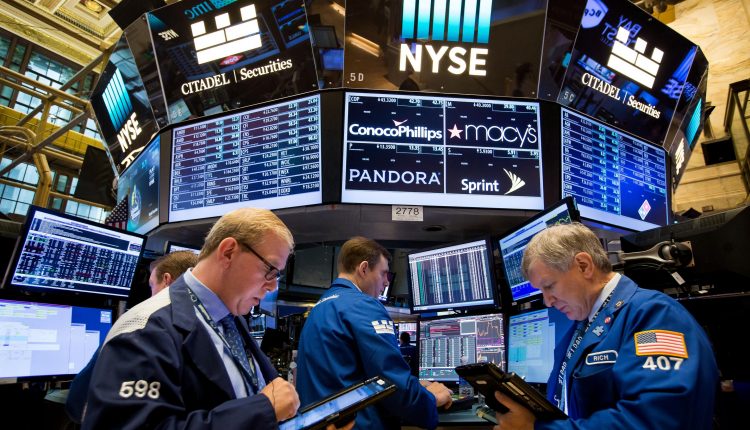U.S stock indexes closed at records again on Tuesday, after five straight days of gains for the three benchmark indexes, supported by positive economic data and relief over a truce in President Trump’s trade war with China.
How did major indexes trade?
The Dow Jones Industrial Average DJIA, +0.11 percent rose 31.27 points, or 0.1 percent to a record close at 28,267.16, while the S&P 500 index SPX, +0.03 percent gained 1.07 points, or less than 0.1 percent, to 3,192.52 to also post a record, and the Nasdaq Composite Index COMP, +0.10 percent gained 9.13 points, or 0.1 percent, at 8,823.36 to a record.
On Monday, all three major indexes also set new record highs. The Dow rallied 100.51 points, or 0.4 percent, to end at 28,235.89, and the S&P 500 advanced 22.65 points, or 0.7 percent, to finish at 3,191.45. The Nasdaq Composite finished at 8,814.23, a gain of 79.35 points, or 0.9 percent.
What drove the market?
U.S. housing and industrial production data suggested parts of the economy improved in November. Home builders increased new construction at an annual pace of 1.365 million in November, an increase of 3.2% from October’s pace and a 13.6 percent increase on a year ago.
Industrial production rose 1.1 percent in November, the largest monthly increase in two years, after the end of the General Motors GM, +0.55 percent strike, but is down 0.8 percent for the past year.
And job openings rose to 7.3 million in October from about 7 million in September, though below the 7.6 million openings last year. The rate at which Americans quit their jobs held steady at 2.3 percent.
“Certainly, as we move through the holiday season, we’ll be keeping an eye on the impact on consumers and consumer sentiment, but also to see how that’s reflected in larger cap areas, like housing,” Eric Wiegand, senior portfolio manager at the Private Client Reserve at U.S. Bank, told MarketWatch.
Joseph LaVorgna, chief economist for the Americas at Natixis, pointed out in a note that declines in homebuilder sentiment has led each of the past three economic downturns by an average of 36 months, so the November housing data makes a 2020 downturn look unlikely.
“We’ve not resolved Brexit or trade or tariff issues, but we’ve got more clarity,” Jennifer Ellison, principal at San Francisco-based BOS, told MarketWatch by phone. “That’s enough to tip the scale and get stocks moving higher again,” she said. “This is a classic Santa Clause rally.”
The U.S. said China agreed to increase imports of goods in 2020 and 2021 by a total of $200 billion more than the total in 2017, including about $40 billion of U.S. farm goods. The deal also included Chinese action to protect American intellectual property and vague assurances not to manipulate its currency.
“Expectations are now for the US and China to finalize the phase-one deal in the first week of January,” wrote Edward Moya, senior market analyst at Oanda, in a note. “As lawyers review the text, it seems this deadline could get pushed even further as not all the terms have been agreed upon,” he added.
Meanwhile, the House of Representatives approved a $1.4 trillion spending package on Tuesday, sending the measure to the Senate and acting just days ahead of another U.S. government shutdown.
Also on the radar though was a decision by Boeing Co. to temporarily shelve its 737 Max production in January, a move Morgan Stanley’s chief U.S. economist Ellen Zentner said would hit the economy hard in the first-quarter.
What companies were in focus?
Shares of Dow component Boeing Co. BA, +0.00 percent closed flat after confirming late Monday it would suspend production of its 737 MAX jetliner.
Apple AAPL, +0.20 percent shares rose 0.2 percent, even after Rosenblatt Securities estimated total sales in China were down 30 percent in November on a year-over-year basis.
Netflix NFLX, +3.70 percent rose 3.7 percent after disclosing good growth numbers internationally.
Pfizer PFE, -0.61 percent lost 0.6 percent after the drug maker said the FDA approved a new indication for a cancer drug it makes with Astellas Pharma Inc.
Shares of Eli Lilly & Co. LLY, +2.02 percent rose 2 percent after the drugmaker provided an upbeat financial outlook for the year ahead.
Bed Bath & Beyond BBBY, +11.24 percent soared 11 percent after the company said six senior executives, including its chief merchandising officer and chief marketing officer, will depart ahead of the announcement of a new plan by Chief Executive Mark Tritton in early 2020.
Navistar International NAV, -10.45 percent reported a decline in fiscal fourth-quarter net earnings and revenue that fell more than analysts expected, while providing a downbeat outlook for 2020 on Tuesday and its stock fell 10.5 percent.
How did other markets trade?
The yield on the 10-year U.S. Treasury note TMUBMUSD10Y, -0.51 percent ended flat at 1.888 percent on Tuesday, after rising 7 basis points Monday.
Crude-oil prices rose for a 4th session in a row Tuesday, with West Texas Intermediate crude CLF20, -0.77 percent for January delivery adding 73 cents, or 1.2 percent to settle at $60.94 a barrel on the New York Mercantile Exchange.
In precious metals, the price of an ounce of gold for February delivery GCG20, +0.09 percent tacked on a dime to trade at $1,480.60 an ounce on Comex.
The value of the U.S. dollar edged higher relative to a basket its major trading partners, with the ICE U.S. Dollar index DXY, +0.06 percent gaining 0.2 percent.
European equities closed mostly lower, but with the U.K.’s FTSE 100 UKX, +0.08 percent, adding 6 points at 7,525.28.
In Asia overnight Monday, stocks closed higher, with the China CSI 300 000300, -0.22 percent rising 1.4 percent, Hong Kong’s Hang Seng Index HSI, -0.13 percent advancing 1.2 percent and Japan’s Nikkei 225 NIK, -0.55 percent gaining 0.5 percent.
Source: Market Watch


